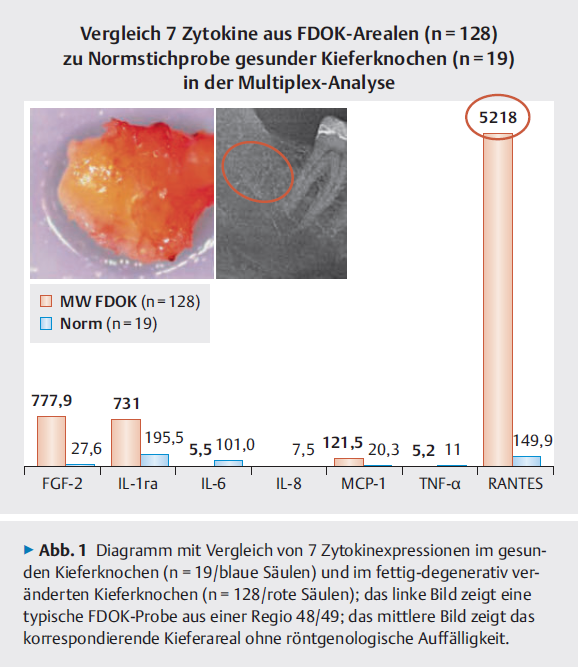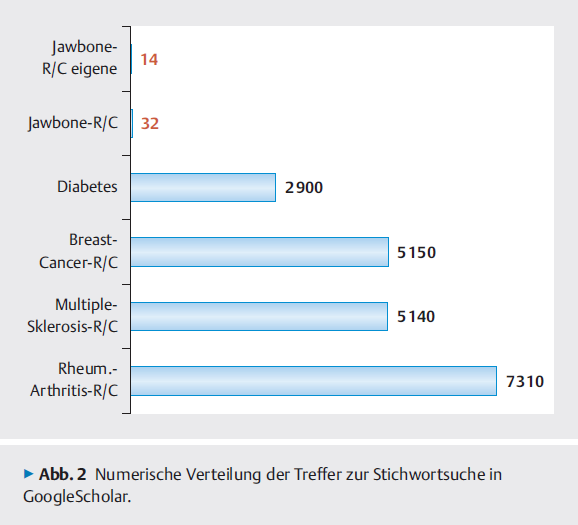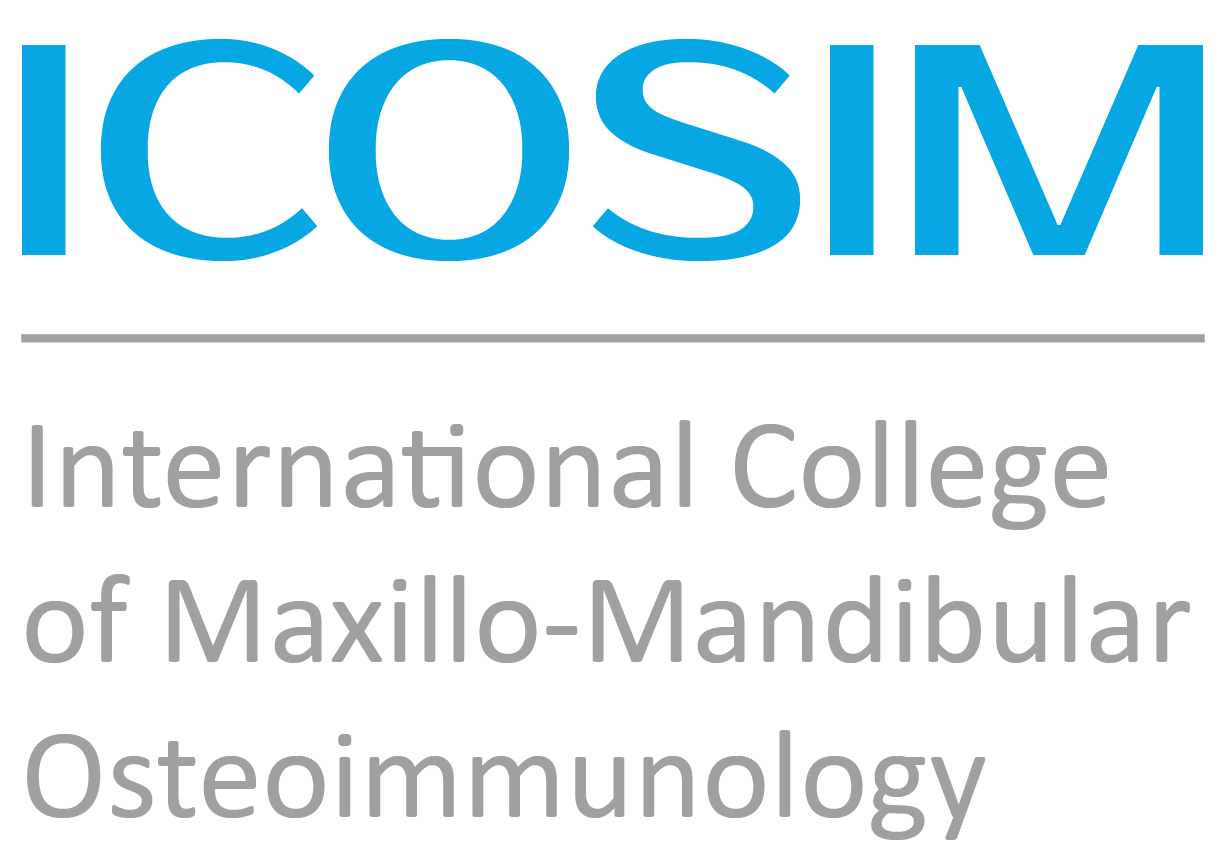The etiology of chronic immuno-inflammatory diseases such as rheumatoid arthritis, multiple sclerosis, tumours and arteriosclerosis is not fully understood. It is generally acknowledged that several factors are interlinked in the development of these diseases, including genetic disposition and factors such as nutrition and environment. Given that holistic dentistry has always suffered a lack of explanatory models accepted by mainstream schools of thought, evidence of the overexpression of the inflammatory chemical messenger RANTES/CCL5 in the jaw is a great advance. A literature search in Google Scholar demonstrates the massive pathogenetic involvement of local RANTES/CCL5 overexpression in the jawbone in almost all chronic conditions.
Chronic diseases lie hidden beneath the surface as a result of an immune system constantly activated by cytokine excesses. These also stimulate various signalling pathways whose expression we were first able to detect in fatty degenerative osteolysis/osteonecrosis of the jawbone (FDOJ) [1]. Our own studies indicate the direct significance of RANTES/CCL5 (R/C) in patients with FDOJ inflammatory reactions in the medullary cavity: in the fatty osteolytic tissue of a FDOJ ( ▶ Fig. 1), very high local levels of R/C were measured in every case we studied, with an up to 35-fold overexpression of R/C. In contrast, the marker cytokines of acute inflammation, such as TNF-α or IL-6 were less expressed than in healthy control bone. However, X-ray presentation of these chronic inflammatory processes presents problems in practice, which accounts for their poor recognition in mainstream dentistry [2,3].
RANTES (=Regulated on Activation, Normal T cell Expressed and Secreted) is a chemokine with chemotactic effect. In literature it is also termed CCL5 RANTES/CCL5 (R/C) is produced by cytotoxic T lymphocytes (CD28+/CD8+) and by neutrophilic and eosinophilic granulocytes and secreted after activation. Chemotaxis and immune activation are the most important functions of R/C: R/C has a chemotactic effect, i.e. it induces the targeted attraction of NK cells, granulocytes, monocytes and macrophages into an existing inflammatory area. It acts on these cells by binding to surface receptors such as CCR3, CCR5 and CCR1 (CCR = chemokine receptor). R/C is therefore involved in many diseases where inflammatory processes occur. However, R/C also acts together with interleukin-2 (IL-2) and interferon-gamma (IFN-γ) to activate NK cells and stimulate them to proliferate.
Our studies [4] indicate the direct significance of R/C in patients with FDOJ inflammatory reactions in the medullary cavity, with a completely unique cytokine profile: in all the FDOJ samples we analysed, very high local R/C levels were measured – with up to a 35-fold overexpression of R/C. In contrast, the marker cytokines for an acute inflammation, such as TNF-α or IL-6, were expressed less strongly than in the healthy control jaw bone (▶ Fig. 1).
Overexpressed R/C cell signals can induce a cascade of dysregulated physiology in many organ systems, leading to the development of multisystem disorders in various forms [5]. An imbalance of cytokines and their respective inhibitors is a feature of chronic inflammatory conditions. Cytokines are involved in triggering the immune response, in the induction of acute inflammatory events and in the transition or persistence of chronic inflammation. This means that, to maintain a healthy state, the cytokine-producing mechanisms must be controlled [6], as many diseases are associated with the release of a storm of bioactive compounds, also represented by pro-inflammatory cytokines such as R/C [7]. Increased R/C levels in the blood occur in many systemic inflammatory diseases. These include rheumatism, allergies, asthma, multiple sclerosis and some tumours. In the past, R/C has not been regarded as having any significance as a laboratory marker for the detection of chronic systemic inflammation, since TNF-α, IP-10 and IL-6 are more sensitive markers.
Against this background, it was of interest to use scientific search engines to search publications and literature on R/C and its associated diseases. We restricted ourselves to searching Google Scholar (GS). GS is a general scientific search engine that searches the internet for references in scientific literature. The advantages of this search engine are a very large database and an algorithm that produces a suitable hit list. The disadvantages of GS are the poor filter function and the lack of intellectual quality checks on the hit list. The numbers presented here for search options are therefore not very robust, and are highly likely to contain numerous multiple references. The medical terminology, pathologies and diseases were entered into GS with the addition of ‘…AND RANTES CCL5’. ‘AND’ was used as a Boolean operator in the search engine to capture the newer term for chemokine CCL5 – Chemokine (C-C motif) ligand 5 – as well as the older term for R/C. The entries were always made in English terminology, in order to access the scientifically indexed published work. ▶ Fig. 2 shows the results obtained in GS when entering the search terms ‘multiple sclerosis, diabetes, rheumatic arthritis and breast cancer’. Using the above-mentioned method, we entered keywords for these 4 diseases and their link to R/C into GS. The range of hits for ‘multiple sclerosis AND RANTES CCL5’ is 5140, for ‘diabetes AND RANTES CCL5’ it was 2900, for ‘rheumatic arthritis AND RANTES CCL5’ it was 7310, and for ‘breast cancer AND RANTES CCL5’ it was 5150. This demonstrates the extent of scientifically proven effects of R/C on the selected clinical conditions using the literature sources listed in GS – a small selection. For reasons of space, the abstracts are heavily reduced and filtered for R/C effect. For your own literature research, the reference can be read directly in medical libraries. For comparison, ‘jawbone AND RANTES CCL5’ was also used as a search term in GS. ▶ Fig. 2 shows the numerical distribution of the hits.
The role of chemokines in the pathogenesis of MS has not yet been adequately studied. RANTES-CSF values (CSF: cerebrospinal fluid) were elevated in MS patients compared with control patients. It has been demonstrated that CNS expression (CNS: Central Nervous System) of R/C is dominant at the edge of active plaque in the brains of MS patients. R/C could be a key proinflammatory factor in MS pathogenesis. The discovery of the causes and the temporal and spatial patterns of chemokine expression during autoimmune demyelinating disease of the CNS opens new potential targets for therapeutic intervention [8]. Several studies have demonstrated the role of chemokines in autoimmune encephalomyelitis (MS); data suggest that the induction of leucocyte adhesion to micro-vessels in the brain is an important mechanism by which R/C contributes to the pathophysiology of MS [9].
Systemic concentrations of R/C were higher in people with IGT or type 2 diabetes than in control subjects. Our results indicate that R/C may be implicated in the development of type 2 diabetes, independently of risk factors related to metabolic syndrome. There is no general upregulation of chemokine production in type 2 diabetes, rather, there is an association between the disease and specific members of the chemokine family [10]. It is known that CCL5/RANTES and its associated receptor CCR5 contribute to neuronal function, as well as to metabolic disorders such as type 2 diabetes mellitus, obesity, atherosclerosis and metabolic changes following HIV infection. Blocking CCR5 switched off insulin signal activation. Taken together, our data show that CCR5 regulates insulin signalling in the hypothalamus, contributing to systemic insulin sensitivity and glucose metabolism [11].
Serum RANTES levels were significantly raised in all onset types of juvenile rheumatoid arthritis (JRA). Serum RANTES concentrations were correlated with C-reactive protein concentrations, haemoglobin levels, white blood cell (WBC) counts and platelet counts. R/C levels in synovial fluid were raised compared with serum levels. Conclusion: R/C is a key molecule in the pathogenesis of all groups of JRA. Serum levels of these CC chemokines represent more sensitive markers of disease activity than conventional markers for inflammation [12]. The selective chemoattractant and activation effects of chemokines on leucocytes identify them as potentially ideal candidates for mediating inflammatory processes in RA. The results demonstrate raised levels of R/C gene expression in circulating RA cells. Histological examination of affected rheumatoid joints revealed extensive R/C expression. These data indicate that R/C plays a central role in immunoregulation and the inflammatory processes of RA [13].
Numerous studies address the involvement and role of R/C in malignant breast tumours: although there is minimal expression of chemokines in normal breast epithelial canal cells, they are strongly expressed by breast tumour cells at primary tumour sites, indicating that R/C expression is acquired in the course of malignant transformation. This suggests that both chemokines play a role in the development and/or progression of breast cancer. In summary, R/C is an inflammatory mediator with promalignancy [14]. Chemokines in tumours are more than just leucocyte attractants. In breast carcinoma, R/C expression in tumour cells is correlated with an advanced stage of the disease, suggesting that R/C may be implicated in breast cancer progression [15].
After research shows that diseases in at least 4 organs are due to inflammatory conditions associated with R/C overexpression, it is all the more surprising that when conducting a 5th search for R/C related inflammatory conditions – using ‘Jawbone and RANTES CCL5’ – the jawbone only produces 32 hits in GS. Of the 32 hits using ‘Jawbone AND RANTES CCL5’, 14 refer to publications by this author and his co-authors. In total, the 32 ‘Jawbone RANTES’ references amount to only 0.17% of all disease-relevant R/C references for the 4 listed clinical conditions. None of the abstracts refers to a direct causal relationship between R/C from FDOJ and any of the cited clinical conditions, although from the plethora of R/C-induced inflammatory processes in organs and regulatory systems, the potential effect of R/C from FDOJ becomes clear.
What can we conclude from searching the literature on GS? Clearly, all the medical research is concerned with R/C overexpression; only dentistry has so far ignored this potential source of disease. On the one hand, R/C is addressed in over 18500 GS hits as a possible key element in a pathogenetic signalling cascade. On the other hand, the extremely low number of R/C studies in the area of FDOJ, researched by ourselves, is particularly striking: the mere 32 hits in GS reveal the lack of scientific or clinical interest in FDOJ, and a resultant ‘silent inflammation’ with subsequent immunological meta-inflammation. This exposes a notable deficit: To date, these FDOJ osteopathies have only been the subject of limited scientific investigation. Their implication in systemic meta-inflammation via immunological R/C signalling pathways has been of little interest, although of course the multitude of GS hits does not constitute evidence of causality in the individual clinical case. In future, greater emphasis should be placed on our pioneering laboratory-based detection of the inflammatory messenger R/C in the jawbone. R/C analysis of FDOJ samples can serve to demonstrate holistic systemic signalling in the jaw region using modern immunological methods. The imbalances documented in the literature research presented here demonstrate the need for further research into R/C-based relationships between ‘silent inflammation’ in the jaw region and systemic diseases. Increased interdisciplinary working, and communication amongst specific areas of expertise could improve the quality of treatment of chronic diseases.



 Deutsch
Deutsch English
English Português do Brasil
Português do Brasil Español
Español